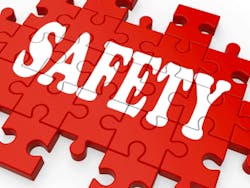Over the past 100 years, the National Safety Council has learned a lot from studying best-in-class EHS programs.
During a keynote address at the 2013 National Safety Congress and Expo in Chicago, National Safety Council CEO Janet Froetscher outlined the four fundamentals that the council sees as the keys to safety success. They are:
- Leadership and employee engagement.
- Safety-management systems.
- Risk reduction.
- Performance measurement.
Leadership and Employee Engagement
The council's Green Cross for Safety medal is "the biggest, most visible way that we celebrate leadership," Froetscher noted.
During her keynote address, Froetscher announced that Toledo, Ohio-based building-products manufacturer Owens Corning is the recipient of the 2013 award. She defined employee engagement as a culture in which "every employee feels accountable for their own safety and the safety of their colleagues."
Froetscher pointed to Alliant Energy Corp. as an example of a company with just such a culture. When Alliant decided to implement a mandatory fall-protection program in 2010, the Madison, Wis.-based utility company assembled a team of management and union members.
"Together, they chose three [fall-protection devices]," Froetscher said. "They gave their employees the choice of a device, and they did peer-to-peer training of all their employees. So they engaged their employees all across the board, and they haven't had a fall since."
Safety-Management Systems
With more and more companies relying on contractors and temporary workers, "best-in-class companies are extending their safety-management systems beyond their own employees," Froetscher said.
Columbus, Ind.-based engine manufacturer Cummins Inc. is a prime example. During the bid process, Cummins stipulates that contractors must adhere to the same safety standards that it does. Even after Cummins awards a bid for contract work, the company conducts a safety audit of the contractor, Froetscher explained.
"They make sure there aren't two different levels of employees – their employees and the contractors," she said. "Everyone shares the same safety standards and the same safety performance."
Risk
The continual identification and reduction of risk is a timeless safety strategy. With the advancement of robotics and manufacturing technology, however, the strategy is evolving.
The National Safety Council's Campbell Institute, along with safety-instrument maker Industrial Scientific Corp., challenged Carnegie Mellon University students to design a robot that would mitigate the risk of installing roof shingles. The students who won the competition were on hand at the 2013 National Safety Congress and Expo in Chicago.
Their solution is an example of how robotics can make workplaces safer, Froetscher asserted. "There will be many more opportunities for technology and robotics to help us eliminate risk," she added.
Performance Measurement
"Best-in-class companies constantly measure to see what works well, and they measure to see what doesn't work so they can stop doing it," Froetscher said. "They measure to predict things before they happen – leading as well as lagging indicators."
